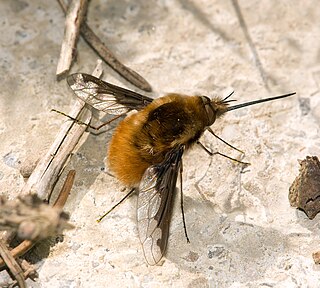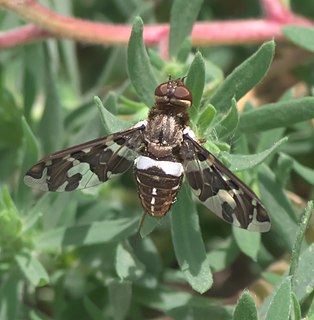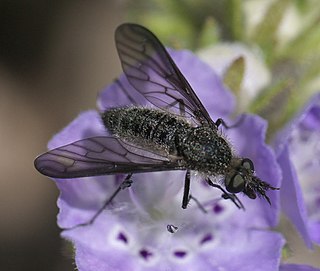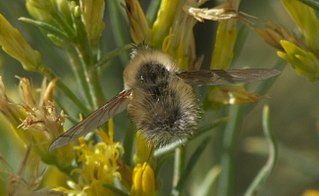
The Bombyliidae are a family of flies, commonly known as bee flies. Adults generally feed on nectar and pollen, some being important pollinators. Larvae are mostly parasitoids of other insects.

Anthrax is a genus of bombyliid flies, commonly known as "bee-flies" due to their resemblance to bees. Most are dull black flies, and are usually small to medium in size, 4–20 millimetres (0.2–0.8 in), and many species have striking wing patterns.
Heterostylum is a genus of flies belonging to the family Bombyliidae (bee-flies). There are 14 described species, distributed throughout the Americas. These are robust and very hairy flies with a body length of 10–15 mm. They can be distinguished from similar genera by an indentation in the hind margin of the eye and unique wing venation.

Villa is a genus of flies belonging to the bee-fly family (Bombyliidae). They range in size from 5 to 17 millimetres, and have typically rounded heads. The males of some species have a brilliant mat of silvery patagial scales. About 270 Villa species are found on all continents except Antarctica. They can be distinguished from similar genera (Hemipenthes) by their wing venation.

Hemipenthes is a large genus of flies belonging to the family Bombyliidae (bee-flies). There are many described species, distributed throughout the Holarctic realm. These are small to large robust flies with a body length of 5–14 mm. They can be distinguished from similar genera (Villa) by their wing venation. A number of species formerly in this genus were moved to a separate genus, ins in 2020.

Balaana is a genus of flies belonging to the family Bombyliidae (bee-flies). There are about seven described species, including three from western Australia. These are robust and very hairy flies with a body length of 10–18 mm (0.4–0.7 in).

Anthracinae is a subfamily of bee flies in the family Bombyliidae. There are more than 80 genera and 2,000 described species in Anthracinae.

Exoprosopini is a tribe of bee flies in the family Bombyliidae. There are more than 20 genera and 760 described species in Exoprosopini.

Conophorini is a tribe of bee flies in the family Bombyliidae.

Eclimini is a tribe of bee flies in the family Bombyliidae. This tribe was formerly considered a subfamily of Bombyliidae, but was transferred to the subfamily Bombyliinae as a result of research published in 2019.

Villini is a tribe of bee flies in the family Bombyliidae.

Anastoechus is a genus of bee flies. There are at least 90 described species in Anastoechus.
Cythereinae is a subfamily of bee flies in the family Bombyliidae. There are about 19 genera and 150 species in Cythereinae.
Heterotropus is a genus of bee flies in the family Bombyliidae. It is the only genus in the subfamily Heterotropinae, which formerly contained at least four genera. There are more than 45 species in the genus Heterotropus.
Lomatiinae is a subfamily of bee flies in the family Bombyliidae. There are about 16 genera and at least 290 described species in Lomatiinae.
Mariobezziinae is a subfamily of bee flies in the family Bombyliidae. There are about 10 genera and at least 50 described species in Mariobezziinae.

Lordotinae is a small subfamily of bee flies in the family Bombyliidae. This subfamily was formerly considered a tribe of Bombyliinae, but was elevated to subfamily as a result of research published in 2019.














